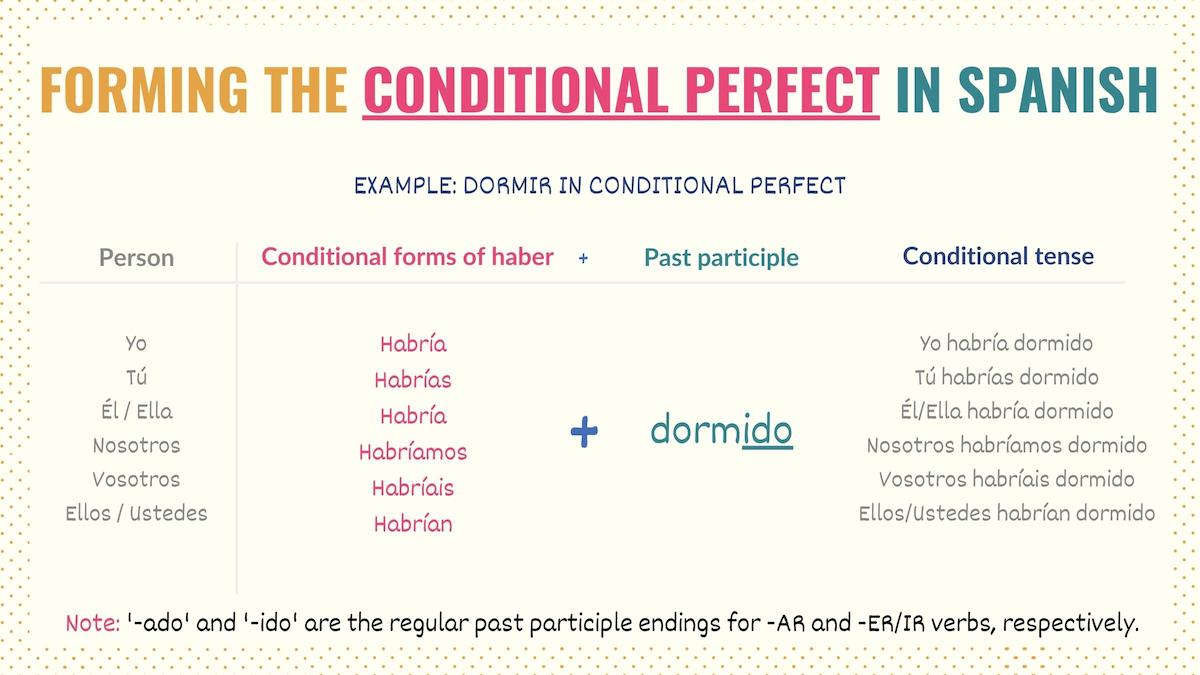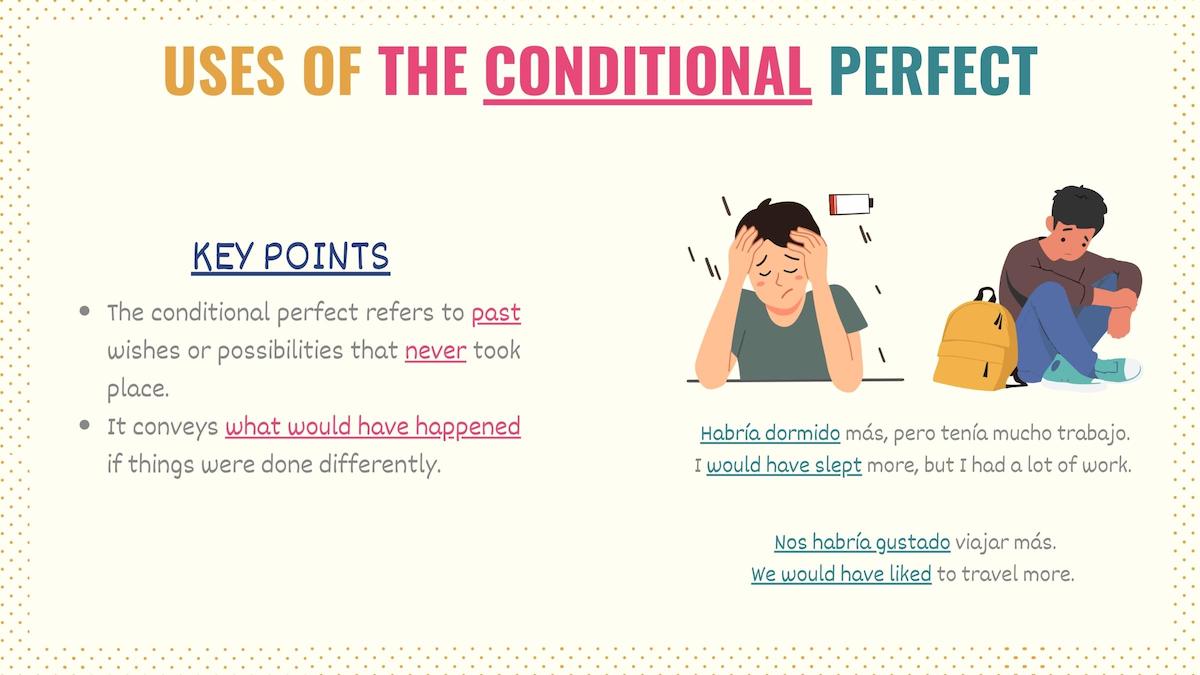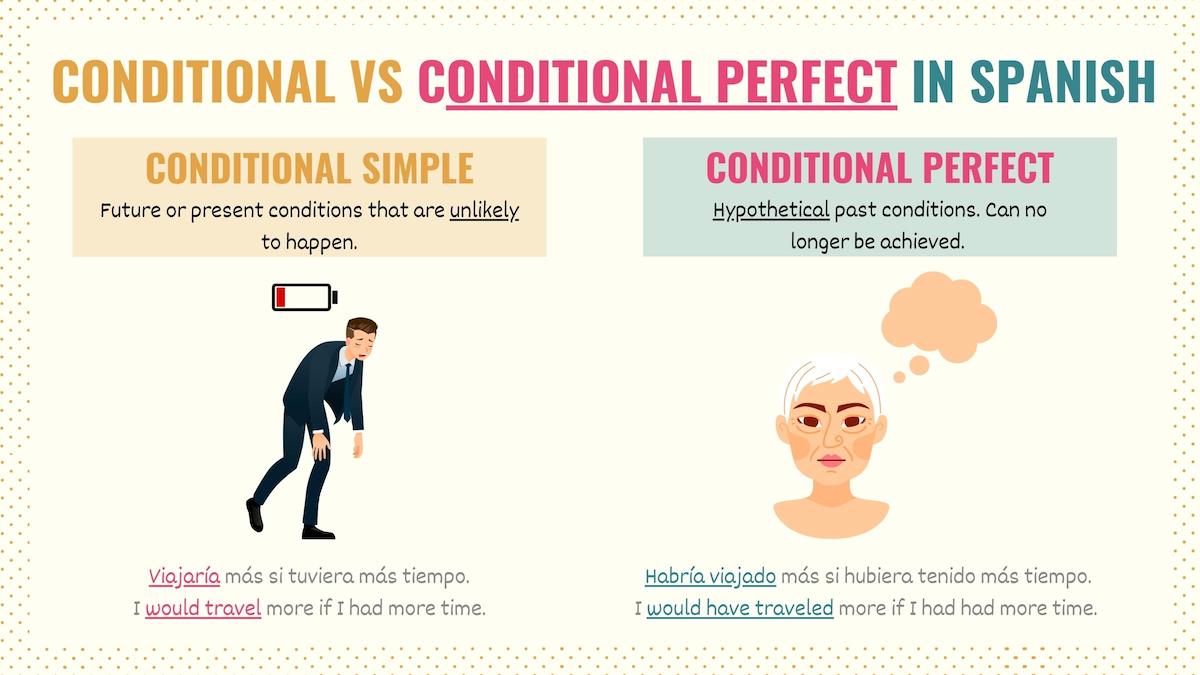The Spanish tenses you learn as a beginner allow you to make statements about actual events or facts –likes, dislikes, habits, routines, plans, etc. However, being able to talk about hypothetical scenarios is also crucial, which is the core application of the conditional perfect Spanish tense.
Seeing this compound tense is key to conveying your ideas with fluency; in this guide, we’ll go over:
- How to Conjugate the Conditional Perfect
- Uses of the Spanish Conditional Perfect Tense
- Difference Between the Conditional & Conditional Perfect
- Key Points
- Next Steps: Additional Resources
Conditional Perfect Spanish Conjugations
As a compound tense, the Spanish conditional perfect is formed by combining the conditional forms of the auxiliary verb (haber) with a past participle (main verb).
Here is a quick reminder of haber’s conditional forms:
- Yo habría: I would have
- Tú habrías: You would have
- Él / Ella / Usted habría: He / She / You would have
- Nosotros habríamos: We would have
- Vosotros habríais: You would have (Castilian Spanish)
- Ellos / Ellas / Ustedes habrían: You would have
Past participles in Spanish are formed by adding the endings -ado and -ido to the root of ‘-ar’ and ‘-er/-ir’ verbs, respectively.
So, now that you know how to conjugate the conditional perfect in Spanish, here are some sentences using this tense:
¿Qué habrías hecho tú?
What would you have done?
Me habría gustado conocer a tu mamá.
I would have liked to meet your mom.
Si la hubiera invitado, no habría venido.
If I had invited her, she would not have come.
Take Note: The verb haber is one of the irregular verbs in the conditional tense. Remember that any verb with an irregular past participle in Spanish will be considered an irregular verb in the conditional perfect. Hacer, decir, abrir, and escribir are examples of these verbs.

When to Use the Conditional Perfect Verbs in Spanish
The conditional perfect Spanish tense expresses hypothetical scenarios that never took place. Simply put, the conditional perfect conveys speculations of things that would have happened if certain circumstances had been met.
In this context, hypothetical scenarios include past possibilities or wishes that never came to happen.
Sentences with the Spanish conditional perfect use different elements depending on what you want to express. To express what would have happened had a specific condition had been fulfilled, you must use si clauses:
[Si clause] + [conditional perfect]
Si me hubieras dicho, habría ido por ti.
If you had told me, I would have picked you up.
Habría sido más fácil si me hubiera ayudado.
It would have been easier if you guys had helped me.
Take Note: If clauses in Spanish can be placed at the start or end of a sentence.
Although it’s commonly used with si statements, this tense can also work with implicit conditions. Often, this is used to express past wishes that can no longer be or to speculate about past events:
Me habría encantado viajar más.
I would have liked to travel more.
Creemos que habrías sido muy feliz con Tom.
We believe you would have been very happy with Tom.
Check example #2. In this sentence, it’s implied that your relationship with Tom is over. So, I use the conditional perfect to imagine your happiness if you had stayed together.
When including the circumstances in your sentence, you can also use the structure:
[Conditional perfect] + pero + [past tense]
Le habría gustado venir, pero estaba ocupada.
She would have loved to come, but she was busy.
Habríamos dormido más, pero nos despertó el bebé.
We would have slept more, but the baby woke us up.
Take Note: In Spanish, the past perfect subjunctive is often used interchangeably with the conditional perfect.

Spanish Conditional vs Conditional Perfect
Even though they both express hypothetical situations, the conditional and conditional perfect refer to different time frames.
The Spanish conditional tense refers to things that are unlikely to happen. These are hypothetical situations in the present or future:
Iría, pero estoy muy ocupada.
I would go, but I’m too busy.
Si mi casa fuera más grande, tendría más perros.
I would have had more dogs if I had had a bigger house.
On the other hand, the conditional perfect expresses things that can no longer happen because a past condition was not met. These are events that could have happened:
Habría ido, pero estuve muy ocupada.
I would have gone, but I was too busy.
Si hubiera tenido una casa más grande, habría tenido más perros.
If I had had a bigger house, I would have had more dogs.

Key Points
This compound tense is crucial to make speculations about past actions. Here are some points you should never forget:
- The Spanish conditional perfect is formed with haber in conditional form + past participle.
- This tense is related to finished events or circumstances.
- Use the conditional tense to speculate about actions that never took place (what would have happened)
- Si clauses + conditional perfect convey the condition and hypothetical result had that circumstance happened.
- Without if clauses, this tense allows you to refer to past wishes or conjectures about a past situation.
- In Spanish, this tense is often interchangeable with the past perfect subjunctive.
Spanish Conditional Perfect Tense Extra Resources
Although you’re already familiar with this tense, here some additional topics can help you master the conditional perfect. First, make sure you know and practice the different conjugations of haber.
Also, take the time to learn how to form regular and irregular past participle verbs. Next, check how Spanish si clauses work and when to use them. Since it’s also a compound tense and easily confused with this topic, you should check what the future perfect is.
Finally, learning how to use and conjugate the Spanish conditional tense can help you reinforce how its compound form works.
Download PDF
The conditional perfect in Spanish is a key tense to express conditions, hypothetical situations, and form si clauses. So, I’ve created this PDF you can download to study its conjugations and uses.



